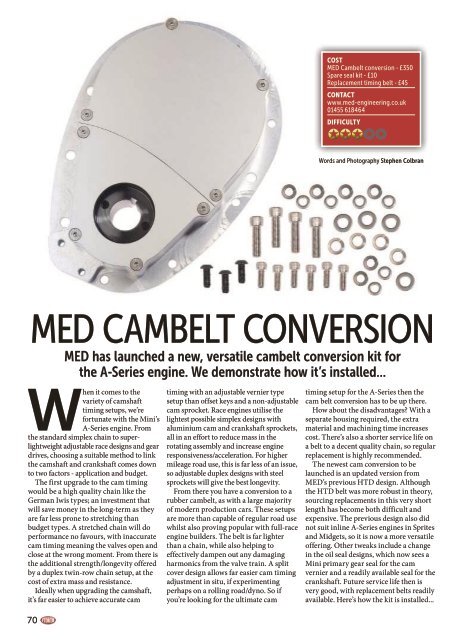You also want an ePaper? Increase the reach of your titles
YUMPU automatically turns print PDFs into web optimized ePapers that Google loves.
COST<br />
MED Cambelt conversion - £350<br />
Spare seal kit - £10<br />
Replacement timing belt - £45<br />
CONTACT<br />
www.med-engineering.co.uk<br />
01455 618464<br />
DIFFICULTY<br />
Words and Photography Stephen Colbran<br />
MED CAMBELT CONVERSION<br />
MED has launched a new, versatile cambelt conversion kit for<br />
the A-Series engine. We demonstrate how it’s installed...<br />
When it comes to the<br />
variety of camshaft<br />
timing setups, we’re<br />
fortunate with the <strong>Mini</strong>’s<br />
A-Series engine. From<br />
the standard simplex chain to superlightweight<br />
adjustable race designs and gear<br />
drives, choosing a suitable method to link<br />
the camshaft and crankshaft comes down<br />
to two factors - application and budget.<br />
The first upgrade to the cam timing<br />
would be a high quality chain like the<br />
German Iwis types; an investment that<br />
will save money in the long-term as they<br />
are far less prone to stretching than<br />
budget types. A stretched chain will do<br />
performance no favours, with inaccurate<br />
cam timing meaning the valves open and<br />
close at the wrong moment. From there is<br />
the additional strength/longevity offered<br />
by a duplex twin-row chain setup, at the<br />
cost of extra mass and resistance.<br />
Ideally when upgrading the camshaft,<br />
it’s far easier to achieve accurate cam<br />
70<br />
timing with an adjustable vernier type<br />
setup than offset keys and a non-adjustable<br />
cam sprocket. Race engines utilise the<br />
lightest possible simplex designs with<br />
aluminium cam and crankshaft sprockets,<br />
all in an effort to reduce mass in the<br />
rotating assembly and increase engine<br />
responsiveness/acceleration. For higher<br />
mileage road use, this is far less of an issue,<br />
so adjustable duplex designs with steel<br />
sprockets will give the best longevity.<br />
From there you have a conversion to a<br />
rubber cambelt, as with a large majority<br />
of modern production cars. These setups<br />
are more than capable of regular road use<br />
whilst also proving popular with full-race<br />
engine builders. The belt is far lighter<br />
than a chain, while also helping to<br />
effectively dampen out any damaging<br />
harmonics from the valve train. A split<br />
cover design allows far easier cam timing<br />
adjustment in situ, if experimenting<br />
perhaps on a rolling road/dyno. So if<br />
you’re looking for the ultimate cam<br />
timing setup for the A-Series then the<br />
cam belt conversion has to be up there.<br />
How about the disadvantages? With a<br />
separate housing required, the extra<br />
material and machining time increases<br />
cost. There’s also a shorter service life on<br />
a belt to a decent quality chain, so regular<br />
replacement is highly recommended.<br />
The newest cam conversion to be<br />
launched is an updated version from<br />
MED’s previous HTD design. Although<br />
the HTD belt was more robust in theory,<br />
sourcing replacements in this very short<br />
length has become both difficult and<br />
expensive. The previous design also did<br />
not suit inline A-Series engines in Sprites<br />
and Midgets, so it is now a more versatile<br />
offering. Other tweaks include a change<br />
in the oil seal designs, which now sees a<br />
<strong>Mini</strong> primary gear seal for the cam<br />
vernier and a readily available seal for the<br />
crankshaft. Future service life then is<br />
very good, with replacement belts readily<br />
available. Here’s how the kit is installed...


